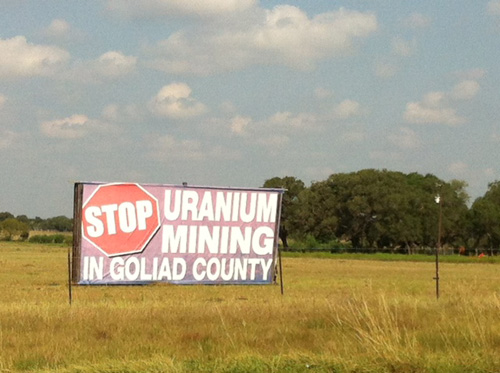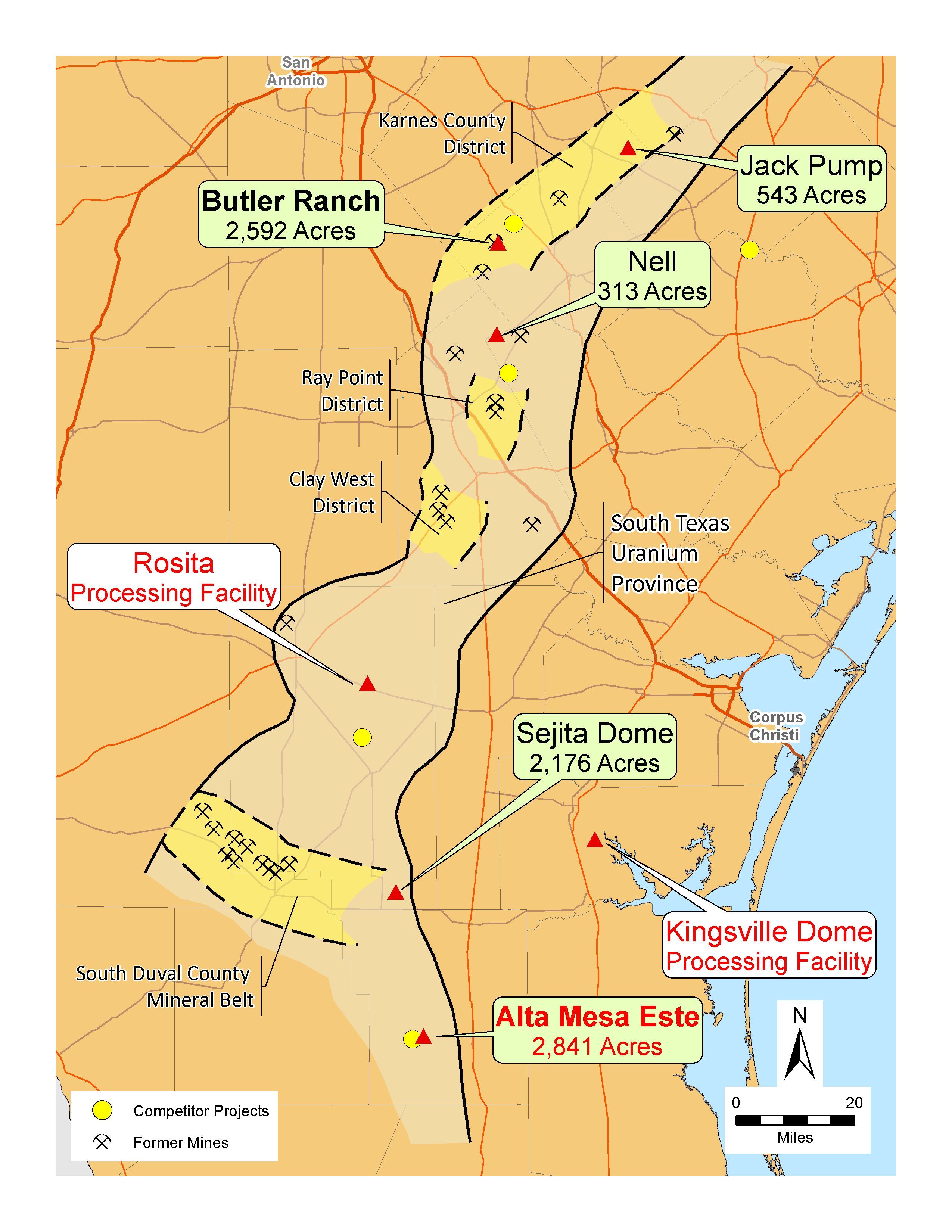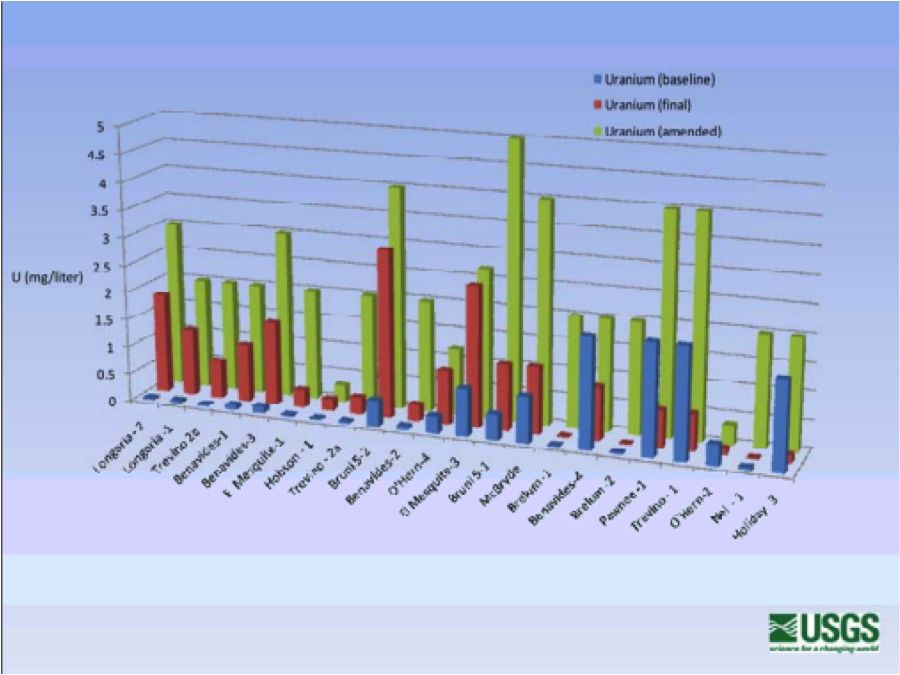
By Evan Waring
Back in December, several media outlets reported on a study released by the U.S. Geological Service (USGS) that found 60 million pounds of uranium deposits in South Texas and estimated that another 200 million pounds of ore remains undiscovered.
To put that in perspective, last year the United States used about 53 million pounds of uranium to power its nuclear plants, meaning the discoveries in Texas could potentially provide up to five years of nuclear fuel if mined.
Uranium is the most common fuel for nuclear power, which currently provides 19 percent of the country’s electricity. In Texas, two nuclear power plants provided about 11 percent of the electric power in the ERCOT region in 2015. Setting aside the risks nuclear plants themselves pose, advocates of nuclear power point to the fact that, unlike coal or gas plants, it does not produce harmful air emissions or CO2. And given the desperate need to reduce carbon pollution and combat climate disruption, it’s tempting to think nuclear power is a good choice to replace fossil fuels with that argument in mind.
Those in favor of nuclear power may see the recent USGS study as good news, and while motives behind nuclear may be well intentioned, the process of mining uranium is harmful to the environment by contaminating groundwater, which have the potential to seep into sources of drinking water.
How uranium is mined
When nuclear energy came to prominence in the 1950s, uranium was first mined through a technique called open pit mining. Even long-abandoned open pit mines are still harmful today, requiring expensive cleanups to mitigate radiation. There are still open pit mines that are being managed in Texas. Today, the primary method of extracting uranium in the U.S. is in-situ leaching (ISL), in which a solution of water, oxygen, and hydrogen peroxide is injected into aquifers, where uranium deposits are often found.
This allows uranium to dissolve in the solution, and the uranium-rich mixture is then pumped back to the surface. From there the uranium is separated from the wastewater, and the waste is then injected back into the ground, supposedly uranium-free.
While ISL is a more efficient and overall less harmful technique than the outdated open pit mining, studies have shown that the uranium content of the water surrounding mining operations often increases. In Texas, 68 percent of areas with in-situ operations had higher levels of uranium than before mining, according to a 2009 USGS study.
But since mining companies usually use the highest level of uranium found throughout the entire aquifer before drilling to compare post-mining levels, the actual percentage could be higher.
Another study by geoscientist Bruce Darling found that out of the 13 samples he collected from Texas ISL sites, which include both exploratory and actual mining operations, all but two contained higher levels of uranium after mining was completed.
Regulators sweep environmental problems under rug

Texas is home to two of seven active ISL mines in the U.S.—the Alta Mesa mine in Brooks County and the La Palangana mine in neighboring Duval County. The regulatory jurisdiction for uranium mining is split between the Railroad Commission (RRC) and the Texas Commission on Environmental Quality (TCEQ). The RRC regulates exploration projects, which are numerous but are only used to discover whether a mine would be profitable, while TCEQ oversees the actual mining operations that produce the bulk of uranium. Many have criticized the shared regulation of in-situ mining between two agencies, and have pointed out that the exploration process can lead to changes in groundwater quality and other potential impacts.
Under TCEQ rules, mining companies are required to perform tests before mining begins to get a “baseline” measurement of uranium content. Some again have criticized this process since the baseline may have changed during the exploratory mining. After mining is completed, according to the TCEQ website, ISL operations must “remove all radiological hazards and restore the groundwater of the now-depleted uranium capture zone back to pre-ISL conditions.” Miners must perform tests to make sure the final results are level with or less than original contaminant levels.
But that requirement can be modified. The same law says that mining companies can request amendments that raise the requirement to above the original contaminant levels, relieving them of punishment after further polluting the water surrounding mining sites.
The law says mining companies can send TCEQ requests to raise the level of uranium content allowed “after appropriate effort has been made to achieve restoration.”
For instance, the graph below from the same 2009 USGS study shows the original (blue) and final (red) levels of uranium at Texas ISL sites (both exploratory and actual mining sites), along with the amended allowable levels that TCEQ approved afterwards. The highest increase from baseline to amended uranium levels was almost 5,000 percent.

The study mentions that the amended restoration values seem to be “relatively arbitrary value[s]” set by TCEQ, demonstrated by “the number of [mines] that set ameded values at rounded whole numbers that were unrelated to any restoration level actually achieved” at the mining sites.
Basically, Texas statutes and rules allow the TCEQ to be flexible with uranium companies to sidestep its own regulations when mining companies have polluted aquifers. The study by Darling found that out of 76 total ISL sites, exploratory and mining, TCEQ approved 51 amendments to raise the maximum uranium concentrations. He did not find an instance where TCEQ has denied an amendment request on record.
This is not including data that both the USGS and Darling study include about other harmful contaminants such as radium, arsenic, sulfate, and many others that end up seeping into groundwater after mining has occurred.
Texans have fought mines in past
In 2008, Uranium Energy Corp. (UEC) announced plans to build an ISL mine in Goliad County, Texas. Residents were concerned about the potential contamination of the aquifer that supplies many of their private wells. After years of legal battles, in 2014 the EPA partly rescinded its exemption of the Safe Drinking Water Act it granted UEC for the Goliad mine previously, citing a lack of evidence that certain areas are not used for drinking water.
The EPA did not fully halt mining in Goliad, but removed certain areas from exemption that could potentially serve wells.
What’s next?
While the news of the recent uranium discovery may have piqued public interest in uranium mining, the environmental consequences are too damaging for it to be worthwhile.
And although companies currently mining in the state may want to expand operations, don’t expect a rush for yellowcake in Southern Texas. After the Fukushima disaster in 2011 caused a renewed skepticism of nuclear power, prices for uranium have fallen to $36 per pound. Prices had been as high as $136 per pound in 2007.
Nuclear utilities aren’t worried about sourcing uranium, either. Fuel makes up such a small portion of their operating costs that prices for yellowcake could more than triple without hurting the bottom line. In addition, reactors are only fueled once a year, so there’s no need for nearby uranium sources. Ninety-four percent of U.S. uranium is imported from foreign countries, mainly Kazakhstan, Australia, and Canada.
The idea of increasing mining in Texas is a lose-lose, especially for nearby communities, even with the goal of a zero-carbon future in mind. We should not support the production of an energy source that is environmentally harmful, and in the case of Fukushima and Chernobyl, disastrous. With climate disruption already drying up our water resources, polluting our remaining water with radioactive chemicals will serve no benefit, not to mention the vast water resources needed to supply nuclear power plants.
Instead, we should continue the increasingly profitable path of investing in 100 percent clean and renewable sources, such as wind and solar, as well as technologies that will help balance these resources, like energy storage and demand response. That way, we all benefit.
Photo: NukeFreeTexas.org